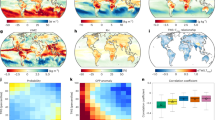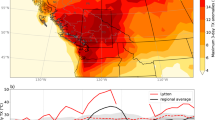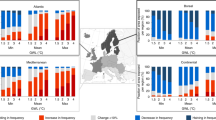Abstract
Spatially compounding extremes pose substantial threats to globally interconnected socio-economic systems. Here we use multiple large ensemble simulations of the high-emissions scenario to show increased risk of compound droughts during the boreal summer over ten global regions. Relative to the late twentieth century, the probability of compound droughts increases by ~40% and ~60% by the middle and late twenty-first century, respectively, with a disproportionate increase in risk across North America and the Amazon. These changes contribute to an approximately ninefold increase in agricultural area and population exposure to severe compound droughts with continued fossil-fuel dependence. ENSO is the predominant large-scale driver of compound droughts with 68% of historical events occurring during El Niño or La Niña conditions. With ENSO teleconnections remaining largely stationary in the future, a ~22% increase in frequency of ENSO events combined with projected warming drives the elevated risk of compound droughts.
This is a preview of subscription content, access via your institution
Access options
Access Nature and 54 other Nature Portfolio journals
Get Nature+, our best-value online-access subscription
$29.99 / 30 days
cancel any time
Subscribe to this journal
Receive 12 print issues and online access
$209.00 per year
only $17.42 per issue
Buy this article
- Purchase on Springer Link
- Instant access to full article PDF
Prices may be subject to local taxes which are calculated during checkout






Similar content being viewed by others
Data availability
All datasets used in the manuscript are publicly available. CESM1 LENS are publicly available through the Cheyenne cluster at /glade/collections/cdg/data/CLIVAR_LE. Observed CHIRPS precipitation data are publicly available at https://www.chc.ucsb.edu/data/chirps. Population and agricultural land datasets are publicly available at NASA Socioeconomic Data and Applications Center (https://sedac.ciesin.columbia.edu).
Code availability
The scripts developed to analyse these datasets are available from the corresponding author on reasonable request, and are also available in ref. 72.
Change history
14 March 2022
A Correction to this paper has been published: https://doi.org/10.1038/s41558-022-01340-6
References
Zscheischler, J. et al. A typology of compound weather and climate events. Nat. Rev. Earth Environ. 1, 333–347 (2020).
AghaKouchak, A. et al. Climate extremes and compound hazards in a warming world. Annu. Rev. Earth Planet. Sci. 48, 519–548 (2020).
Zscheischler, J. et al. Future climate risk from compound events. Nat. Clim. Change 8, 469–477 (2018).
Leonard, M. et al. A compound event framework for understanding extreme impacts. WIREs Clim. Change 5, 113–128 (2014).
Raymond, C. et al. Understanding and managing connected extreme events. Nat. Clim. Change 10, 611–621 (2020).
Sarhadi, A., Ausín, M. C., Wiper, M. P., Touma, D. & Diffenbaugh, N. S. Multidimensional risk in a nonstationary climate: joint probability of increasingly severe warm and dry conditions. Sci. Adv. 4, aau3487 (2018).
Mishra, V., Thirumalai, K., Singh, D. & Aadhar, S. Future exacerbation of hot and dry summer monsoon extremes in India. npj Clim. Atmos. Sci. 3, 1–9 (2020).
Raveh-Rubin, S. & Wernli, H. Large-scale wind and precipitation extremes in the Mediterranean: a climatological analysis for 1979–2012. Q. J. R. Meteorol. Soc. 141, 2404–2417 (2015).
Kornhuber, K. et al. Amplified Rossby waves enhance risk of concurrent heatwaves in major breadbasket regions. Nat. Clim. Change 10, 48–53 (2020).
Heslin, A. et al. Simulating the cascading effects of an extreme agricultural production shock: global implications of a contemporary US dust bowl event. Front. Sustain. Food Syst. 4, 1–12 (2020).
Anderson, W., Seager, R., Baethgen, W. & Cane, M. Trans-Pacific ENSO teleconnections pose a correlated risk to agriculture. Agric. Meteorol. 262, 298–309 (2018).
Anderson, W. B., Seager, R., Baethgen, W., Cane, M. & You, L. Synchronous crop failures and climate-forced production variability. Sci. Adv. 5, 1–10 (2019).
Gaupp, F., Hall, J., Hochrainer-stigler, S. & Dadson, S. Changing risks of simultaneous global breadbasket failure. Nat. Clim. Change 10, 54–57 (2019).
Tigchelaar, M., Battisti, D. S., Naylor, R. L. & Ray, D. K. Future warming increases probability of globally synchronized maize production shocks. Proc. Natl Acad. Sci. USA 115, 6644–6649 (2018).
Singh, D. et al. Climate and the global famine of 1876–78. J. Clim. 31, 9445–9467 (2018).
Mehrabi, Z. & Ramankutty, N. Synchronized failure of global crop production. Nat. Ecol. Evol. 3, 780–786 (2019).
Mills, E. Insurance in a climate of change. Science 309, 1040–1044 (2005).
Levermann, A. Climate economics: make supply chains climate-smart. Nature 506, 27–29 (2014).
Singh, J., Moetasim, A., Skinner, C. B., Anderson, W. B. & Deepti, S. Amplified risk of spatially compounding droughts during co-occurrences of modes of natural ocean variability. npj Clim. Atmos. Sci. 4, 1–14 (2021).
Rogers, C. D. W. et al. Recent increases in exposure to extreme humid-heat events disproportionately affect populated regions. Geophys. Res. Lett. 48, 1–13 (2021).
Anderson, W. B., Seager, R., Baethgen, W., Cane, M. & You, L. Synchronous crop failures and climate-forced production variability. Sci. Adv. 5, 1–10 (2019).
IPCC Managing the Risks of Extreme Events and Disasters to Advance Climate Change Adaptation (eds Field, C. B. et al.) (Cambridge Univ. Press, 2012).
Kitoh, A. et al. Monsoons in a changing world: a regional perspective in a global context. J. Geophys. Res. Atmos. 118, 3053–3065 (2013).
Byers, E. et al. Global exposure and vulnerability to multi-sector development and climate change hotspots. Environ. Res. Lett. 13, 055012 (2018).
Han, T., Wang, H. & Sun, J. Strengthened relationship between eastern ENSO and summer precipitation over northeastern China. J. Clim. 30, 4497–4512 (2017).
Kumar, K. K., Rajagopalan, B. & Cane, M. A. On the weakening relationship between the Indian monsoon and ENSO. Science 284, 2156–2159 (1999).
Silvestri, G. E. El Niño signal variability in the precipitation over southeastern South America during austral summer. Geophys. Res. Lett. 31, 1–5 (2004).
Wang, B., Liu, J., Kim, H. J., Webster, P. J. & Yim, S. Y. Recent change of the global monsoon precipitation (1979–2008). Clim. Dyn. 39, 1123–1135 (2012).
Cook, B. I. et al. Twenty-first century drought projections in the CMIP6 forcing scenarios. Earth’s Future 8, 1–20 (2020).
Rowell, D. P., Booth, B. B. B., Nicholson, S. E. & Good, P. Reconciling past and future rainfall trends over East Africa. J. Clim. 28, 9768–9788 (2015).
Jones, B. & O'Neill, B. C. Spatially explicit global population scenarios consistent with the shared socioeconomic pathways. Environ. Res. Lett. 11, 084003 (2016).
Cai, W. et al. Increased frequency of extreme La Niña events under greenhouse warming. Nat. Clim. Change 5, 132–137 (2015).
Cai, W. et al. Increasing frequency of extreme El Niño events due to greenhouse warming. Nat. Clim. Change 4, 111–116 (2014).
Herrera-Estrada, J. E. et al. Reduced moisture transport linked to drought propagation across North America. Geophys. Res. Lett. 46, 5243–5253 (2019).
Miralles, D. G., Gentine, P., Seneviratne, S. I. & Teuling, A. J. Land–atmospheric feedbacks during droughts and heatwaves: state of the science and current challenges. Ann. NY Acad. Sci. 1436, 19–35 (2019).
Pascale, S. et al. Weakening of the North American monsoon with global warming. Nat. Clim. Change 7, 806–812 (2017).
Lee, J. Y. & Wang, B. Future change of global monsoon in the CMIP5. Clim. Dyn. 42, 101–119 (2014).
Wang, B., Jin, C. & Liu, J. Understanding future change of global monsoons projected by CMIP6 models. J. Clim. 33, 6471–6489 (2020).
Takahashi, H. G. et al. Response of the asian summer monsoon precipitation to global warming in a high-resolution global nonhydrostatic model. J. Clim. 33, 8147–8164 (2020).
Chiodi, A. M. & Harrison, D. E. Global seasonal precipitation anomalies robustly associated with El Niño and La Niña events—an OLR perspective. J. Clim. 28, 6133–6159 (2015).
Deser, C. et al. Insights from Earth system model initial-condition large ensembles and future prospects. Nat. Clim. Change 10, 277–286 (2020).
Fasullo, J. T., Otto-Bliesner, B. L. & Stevenson, S. ENSO’s changing influence on temperature, precipitation, and wildfire in a warming climate. Geophys. Res. Lett. 45, 9216–9225 (2018).
Yun, K.-S. et al. Increasing ENSO–rainfall variability due to changes in future tropical temperature–rainfall relationship. Commun. Earth Environ. 2, 4–10 (2021).
Fredriksen, H. B., Berner, J., Subramanian, A. C. & Capotondi, A. How does El Niño–Southern Oscillation change under global warming—a first look at CMIP6. Geophys. Res. Lett. 47, GL090640 (2020).
Cai, W. et al. Changing El Niño–Southern Oscillation in a warming climate. Nat. Rev. Earth Environ. 2, 628–644 (2021).
Lengaigne, M. & Vecchi, G. A. Contrasting the termination of moderate and extreme El Niño events in coupled general circulation models. Clim. Dyn. 35, 299–313 (2010).
Detailed Trade Matrix. Food and Agriculture Organization of the United Nations (FAOSTAT, accessed 1 March 2021); http://www.fao.org/faostat/en/#data/
Dalin, C., Wada, Y., Kastner, T. & Puma, M. J. Groundwater depletion embedded in international food trade. Nature 543, 700–704 (2017).
D'Odorico, P. et al. Global virtual water trade and the hydrological cycle: patterns, drivers, and socio-environmental impacts. Environ. Res. Lett. 14, 053001 (2019).
Graham, N. T. et al. Future changes in the trading of virtual water. Nat. Commun. 11, 1–7 (2020).
Barnston, A. G., Tippett, M. K., L’Heureux, M. L., Li, S. & Dewitt, D. G. Skill of real-time seasonal ENSO model predictions during 2002–11: Is our capability increasing? Bull. Am. Meteorol. Soc. 93, 631–651 (2012).
Kay, J. E. et al. The community earth system model (CESM) large ensemble project: a community resource for studying climate change in the presence of internal climate variability. Bull. Am. Meteorol. Soc. 96, 1333–1349 (2015).
Funk, C. et al. The climate hazards infrared precipitation with stations—a new environmental record for monitoring extremes. Sci. Data 2, 1–21 (2015).
Shannon, C. A mathematical theory of communication. Bell Syst. Tech. J. 27, 623–656 (1948).
Gao, J. Global 1-km Downscaled Population Base Year and Projection Grids Based on the Shared Socioeconomic Pathways, Revision 01 (NASA, 2020).
Ramankutty, N., Evan, A. T., Monfreda, C. & Foley, J. A. Global Agricultural Lands: Croplands, 2000 (NASA, 2010).
Mishra, A. K., Özger, M. & Singh, V. P. An entropy-based investigation into the variability of precipitation. J. Hydrol. 370, 139–154 (2009).
Vicente-Serrano, S. M., Beguería, S. & López-Moreno, J. I. A multiscalar drought index sensitive to global warming: the standardized precipitation evapotranspiration index. J. Clim. 23, 1696–1718 (2010).
Beguería, S., Vicente-Serrano, S. M., Reig, F. & Latorre, B. Standardized precipitation evapotranspiration index (SPEI) revisited: Parameter fitting, evapotranspiration models, tools, datasets and drought monitoring. Int. J. Climatol. 34, 3001–3023 (2014).
Milly, P. C. D. & Dunne, K. A. Potential evapotranspiration and continental drying. Nat. Clim. Change 6, 946–949 (2016).
Yang, Y., Roderick, M. L., Zhang, S., McVicar, T. R. & Donohue, R. J. Hydrologic implications of vegetation response to elevated CO2 in climate projections. Nat. Clim. Change 9, 44–48 (2019).
Berg, A. & McColl, K. A. No projected global drylands expansion under greenhouse warming. Nat. Clim. Change 11, 331–337 (2021).
Kooperman, G. J. et al. Plant physiological responses to rising CO2 modify simulated daily runoff intensity with implications for global-scale flood risk assessment. Geophys. Res. Lett. 45, 12457–12466 (2018).
Mankin, J. S. et al. Influence of internal variability on population exposure to hydroclimatic changes. Environ. Res. Lett. 12, 044007 (2017).
McKee, B. T., Nolan, D. J. & John, K. The relationship of drought frequency and duration to time scales. In 8th Conference on Applied Climatology 179–184 (1993).
Mishra, A. K. & Singh, V. P. A review of drought concepts. J. Hydrol. 391, 202–216 (2010).
Batibeniz, F. et al. Doubling of U.S. population exposure to climate extremes by 2050. Earth’s Future 8, 1–14 (2020).
O’Neill, B. C. et al. Achievements and needs for the climate change scenario framework. Nat. Clim. Change 10, 1074–1084 (2020).
Rayner, N. A. et al. Global analyses of sea surface temperature, sea ice, and night marine air temperature since the late nineteenth century. J. Geophys. Res. D https://doi.org/10.1029/2002JD002670 (2003).
Maher, N., Matei, D., Milinski, S. & Marotzke, J. ENSO change in climate projections: forced response or internal variability? Geophys. Res. Lett. 45, 11,390–11,398 (2018).
Good, P. I. Permutation Tests: A Practical Guide to Resampling Methods for Testing Hypotheses (Springer, 1994).
Singh, J. et al. Enhanced Risk of Concurrent Regional Droughts with Increased ENSO Variability and Warming (Zenodo, 2021); https://doi.org/10.5281/zenodo.5759291
Acknowledgements
We would like to thank the National Center for Atmospheric Research (NCAR), Climate Hazards Center UC Santa Barbara and US CLIVAR Working Group on Large Ensembles for archiving and enabling public access to their data. We thank Washington State University for the startup funding that has supported J.S. and D.S. W.B.A. acknowledges funding from Earth Institute Postdoctoral Fellowship. M.A. was supported by the US Air Force Numerical Weather Modeling Program and the National Climate‐Computing Research Center, which is located within the National Center for Computational Sciences at the ORNL and supported under a Strategic Partnership Project (no. 2316‐T849‐08) between DOE and NOAA. This manuscript has been co-authored by employees of Oak Ridge National Laboratory, managed by UT Battelle, LLC, under contract no. DE-AC05-00OR22725 with the US Department of Energy (DOE). The publisher, by accepting the article for publication, acknowledges that the US Government retains a non-exclusive, paid-up, irrevocable, world-wide license to publish or reproduce the published form of this manuscript, or allow others to do so, for US Government purposes. The US DOE will provide public access to these results of federally sponsored research in accordance with the DOE Public Access Plan (http://energy.gov/downloads/doe-public-access-plan).
Author information
Authors and Affiliations
Contributions
J.S., M.A., C.B.S., W.B.A., V.M. and D.S. conceived and designed the study. J.S. collected the data and performed the analyses. All authors were involved in discussions of the results. J.S. and D.S. wrote the manuscript with feedback from all authors.
Corresponding author
Ethics declarations
Competing interests
The authors declare no competing interests.
Peer review
Peer review information
Nature Climate Change thanks Mandy Freund and the other, anonymous, reviewer(s) for their contribution to the peer review of this work.
Additional information
Publisher’s note Springer Nature remains neutral with regard to jurisdictional claims in published maps and institutional affiliations.
Extended data
Extended Data Fig. 1 Observed CHIRPS (1981-2018) summer (June-September) precipitation characteristics over SREX regions considered in this study.
(a) Map shows the fraction of annual precipitation that falls in summer season. (b) Map shows the summer precipitation entropy value over land. (c) Significant (P-value < 0.05) linear regression coefficients between ENSO and JJAS precipitation. (d) Map showing the 10 SREX regions (maroon boxes) considered in this study. Maroon text indicates the fraction of each SREX region with high entropy values [entropy > 4.86, which is the median entropy value across 10 SREX regions] (teal) estimated from observed CHIRPS precipitation data (1981-2018) at 0.250 resolution. The regions shown in teal are used to estimate compound drought characteristics.
Extended Data Fig. 2 Agricultural land and population exposure to moderate compound droughts.
Same as Fig. 2a, but for moderate compound droughts.
Extended Data Fig. 3 Climatology of precipitation and evapotranspiration.
Seasonal climatology of precipitation and evapotranspiration and their projected changes in late-21st century (2071–2100) relative to historical (1971-2100) climate.
Extended Data Fig. 4 Regional exposures to severe compound droughts.
Regional (a) cropland and (b) pastureland exposure risk to severe compound droughts in the historical (1971-2000) and late-21st century (2071–2100) climate. Error bars indicate uncertainties (ensemble spread; ±1σ) in the drought likelihood and exposures.
Extended Data Fig. 5 El Niño and La Niña characteristics.
Relationship between meridional sea surface temperature (SST) gradient and Niño3 rainfall in historical (1971-2000; top row) and late-21st century (2071-2100; bottom row) climate. Dark red, orange, navy blue, and sky-blue dots indicate extreme El Niño (defined as events with Niño3 JJAS rainfall exceeds 4 mm/day), moderate El Niño (defined as events with detrended Niño3 SST anomalies are > 0.5σ and that are not extreme El Niño events), extreme La Niña (defined as events with detrended Niño4 SST anomalies < -1.75σ), and moderate La Niña (defined as events with detrended Niño4 SST anomalies < -0.5σ and that are not extreme La Niña events) events, respectively. Text in each panel indicates the number of extreme El Niño, moderate El Niño, extreme La Niña, and moderate La Niña events.
Supplementary information
Supplementary Information
Figs. 1–5 and Table 1.
Rights and permissions
About this article
Cite this article
Singh, J., Ashfaq, M., Skinner, C.B. et al. Enhanced risk of concurrent regional droughts with increased ENSO variability and warming. Nat. Clim. Chang. 12, 163–170 (2022). https://doi.org/10.1038/s41558-021-01276-3
Received:
Accepted:
Published:
Issue Date:
DOI: https://doi.org/10.1038/s41558-021-01276-3
This article is cited by
-
Global land drought hubs confounded by teleconnection hotspots in equatorial oceans
npj Climate and Atmospheric Science (2024)
-
Research progresses and prospects of multi-sphere compound extremes from the Earth System perspective
Science China Earth Sciences (2024)
-
Evolution of drought characteristics and propagation from meteorological to agricultural drought under the influences of climate change and human activities
Environmental Science and Pollution Research (2024)
-
Projected changes of compound droughts and heatwaves in China under 1.5 °C, 2 °C, and 3 °C of global warming
Climate Dynamics (2024)
-
Was the 2022 drought in the Yangtze River Basin, China more severe than other typical drought events by considering the natural characteristics and the actual impacts?
Theoretical and Applied Climatology (2024)



